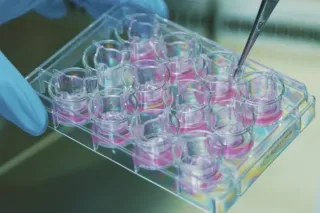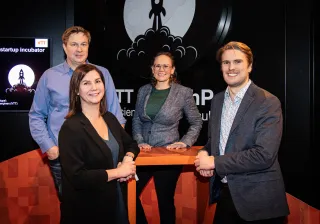Hyperspectral imaging is an extremely accurate method to identify and distinguish different materials based on the light reflection properties of chemical compounds. Specim set out to miniaturise chemical imaging from bulky industrial equipment down to a hand-held, point-and-shoot device for more efficient plant stress and disease monitoring.
Challenge
- Hyperspectral imaging is used to analyse materials in research, plant breeding, crime investigation and many other fields
Present technology is bulky and difficult if not impossible to use in the field
How to miniaturise the technology to truly portable format without compromising performance?
Solution
- Specim, together with VTT, squeezed the technology into a device the size of an ordinary camera
- Calculations are performed inside the camera, on the spot and in seconds
- VTT brought vital algorithm and UI/UX knowhow into the product development to create an intuitive and easy-to-use user interface for the mobile hyperspectral camera platform.
Benefit
- The small size of the camera now enables easy use in the field
- nalyses no longer require bulky equipment
- True mobility, advanced detection capabilities and affordable price expands hyperspectral imaging to new use cases.
In 1993, VTT researchers, in collaboration with NASA, developed the world’s first spectrographic imaging systems for professional airborne use. In 1995, three of these researchers founded a company, Specim, to commercialise this work. Since then, Specim has been in the forefront of reliable high-performance hyperspectral imaging technologies, used in research institutes, universities, the pharma industry, geology, military applications, environmental analytics, hydrology, plant breeding and crime labs. They operate through chemical imaging, capable of establishing the chemistry of materials and changes occurring in them. More than 6,000 Specim instruments and spectrographs are in daily use around the world. The company has received several innovation awards and sizable external capital investment.
Hyperspectral imaging sees more than the eye
Hyperspectral imaging provides significant speed and accuracy in monitoring crop plants and vegetation, for example stress and disease detection in the field or in a greenhouse. Differences in the material composition and biological well-being of living plants can be accurately identified. If a plant disease is found in one location in the field, the device will find the same disease in other locations where it might not be visible to the eye. The ability to detect and characterise plant diseases rapidly and in a cost-efficient way differentiates this technology from other technologies.
On a wider scale, hyperspectral imaging provides an effective method to monitor entire vegetation ecosystems. So-called Vegetation Indices calculated from the visible and near-infrared spectrum are commonly used to evaluate structural and functional traits in vegetation both qualitatively and quantitatively, which aids in estimating photosynthesis efficiency. These capabilities help improve the quality and safety monitoring in food production – in precision agriculture, for example, the findings can be applied to site-specific fertilisation or precise plant protection with pesticides.
Technology in truly mobile format
Until now, hyperspectral imaging devices, initially designed for industrial and research purposes, have been rather bulky and difficult to move. Specim set out to miniaturise the technology so that it fits into a device about the size of an ordinary DSLR camera. Such a device is easy to carry by any person and it allows point-and-shoot operation with enough data processing power inside the camera to identify the materials under investigation instantly and on the spot.
Specim started the development of this technology and specified the use cases, but workable, simple-enough ways to implement the technology were still to be discovered. The challenge was not only how to miniaturise the technology but also how to enable the use of camera by non-technical users who are not necessarily experts in data processing, machine learning or hyperspectral spectroscopy.
Innovators meet researchers
Specim contracted VTT to find a practical way of achieving its goals – miniaturising the spectral imaging technology and, specifically, automating the usage of camera in the identification of materials. VTT’s contribution was to develop simple, robust and fast-enough operating protocols for the camera use cases.
The project was carried out in collaboration between Specim and VTT’s optical measurement and intelligent industry experts from the Knowledge Intensive Products and Services (KIPS) business area.
In the beginning, VTT did pioneering work in drafting the necessary data processing and calculation methodologies that set the course for the final user interface and user experience (UI/UX) design by matching the use cases and data processing protocols. The solution builds on advanced push broom technology with proprietary implementation elements, making use of VTT’s competencies and know-how in chemometrics and its applications to spectroscopic devices since the 1980s.
VTT brought vital algorithm and UI/UX knowhow into the project when we set the target to create an intuitive and easy-to-use user interface for the mobile hyperspectral camera platform. Cooperation with the VTT team was truly seamless and we were privileged to work with world-class professionals and involve their expertise in Specim IQ development,
says Harri Salo, Program Manager, Specim.
Revolutionary results in practical use cases
The result of the collaboration was the world’s first mobile hyperspectral camera using push broom technology, and with advanced detection capabilities. In the fast screening mode, the user aims at the target object, takes a “picture”, points to the material of interest in the taken image, and the device then automatically identifies this material elsewhere in the image and any succeeding images.
In the application mode, the camera uses spectral libraries and supervised models pre-loaded into the device to carry out more thorough investigations. In both use cases, all calculations take place inside the camera on the spot while using it. Naturally, calculations can be performed with a PC, and the resulting apps can be downloaded into the camera. The innovation allows vastly improved mobility and usage of spectrographic imaging devices.
Even the VTT experts, Pekka Teppola, Pasi Hyttinen and Kimmo Solehmainen, were amazed by the achieved miniaturising level when they saw the equipment for the first time. They had been using the technology for 20 years, but to have a fully working device was very emotional and enlightening of how big Specim’s development steps had been.
Besides the miniaturised technology, the ease of use of the new camera makes the innovation truly revolutionary. Monitoring vegetation wellbeing no longer requires bulky equipment that is difficult to set up and even impossible to use in the field, instead, analyses can now be performed in the desired location as simply as ordinary photography.
A boost to Specim’s business
Specim’s long-term commitment to developing hyperspectral imaging is bearing fruit. Since the product is so easy to use and can be tailored with applications, it will attract customers also from completely new application fields that have not used the technology before.
Specim IQ is a product that will have a major effect on our business and on hyperspectral imaging business in general. We estimate that this will increase our revenue by 30% already in 2018, and expect to see even stronger growth in the future,
says Georg Meissner, Specim’s Managing Director.





